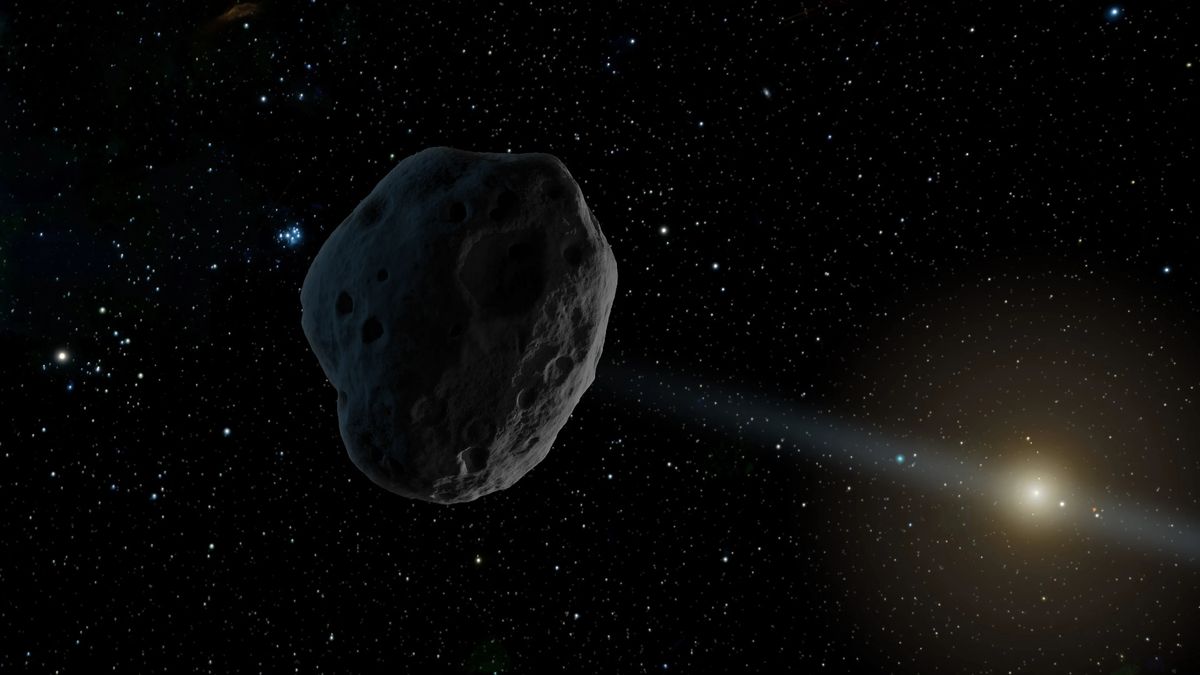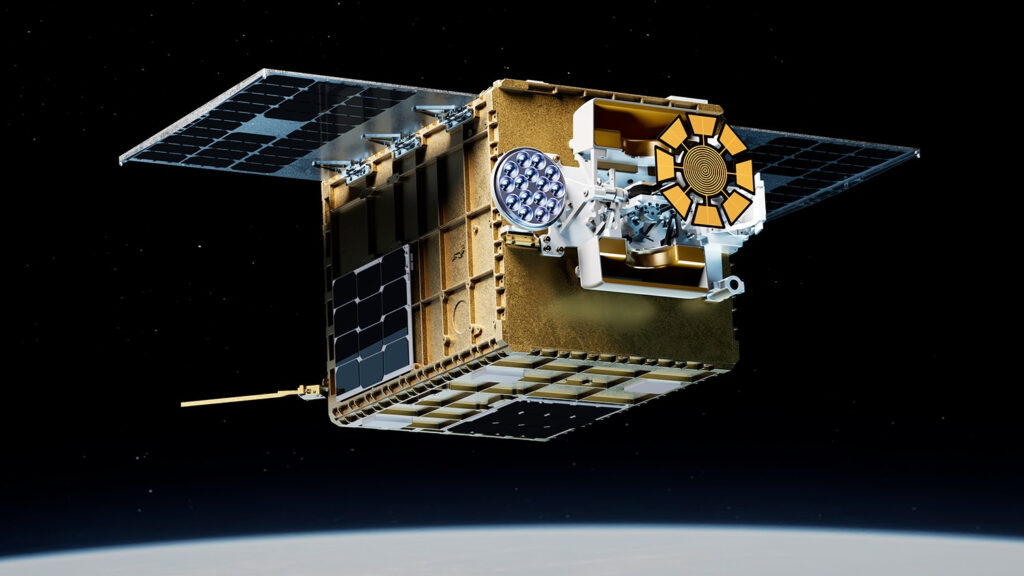Now Reading: Astronomers discover 7 new ‘dark comets,’ but what exactly are they?
-
01
Astronomers discover 7 new ‘dark comets,’ but what exactly are they?
Astronomers discover 7 new ‘dark comets,’ but what exactly are they?


Scientists have discovered seven more “dark comets,” and analysis of this haul suggests that the puzzling planetoids are divided into two distinct families, further deepening the mystery of why these objects look like asteroids but behave like comets.
Of late, the dividing line between asteroids and comets has become blurred. There are “main-belt comets,” also known as active asteroids, which are comet-like objects possessing the properties of asteroids. Then there are dark comets, which are the opposite: asteroids that have some of the characteristics of comets.
As their name suggests, main-belt comets tend to inhabit the main asteroid belt between Mars and Jupiter. But they grow tails just like a comet, whereas dark comets have no tails but move like a comet, in the sense that they display non-gravitational acceleration. In other words, some other force besides gravity is acting on their motion, changing their trajectory. For a regular comet, this other force is the thrust produced by ices sublimating into vapor on their surface when they near the heat of the sun and outgas into space, carrying the dust that produces their iconic tails. Yet dark comets have no tails.
“When you see that kind of perturbation on a celestial object, it usually means it’s a comet, with volatile material outgassing from its surface giving it a little thrust,” Davide Farnocchia, of NASA’s Jet Propulsion Laboratory in Southern California, said in a statement. “But try as we might, we couldn’t find any signs of a comet’s tail.”
Related: Comets: Everything you need to know about the ‘dirty snowballs’ of space
We’ve seen this mysterious motion before. In 2017, the interstellar object 1I/’Oumuamua sped through the inner solar system before heading back toward interstellar space. As it did so, its trajectory altered from that which gravity alone had planned for it — ‘Oumuamua seemed to be getting an extra push from somewhere.
Although no tails or outgassing were detected coming from ‘Oumuamua, causing its mystery to linger, ‘Oumuamua’s behavior bore a remarkable resemblance to another object found to be acting strangely just a year earlier.
That object, known as 2003 RM, had been thought to be just another asteroid, until it too was noticed to be moving under a non-gravitational force.
“The fact that the first object we discovered from interstellar space exhibited similar behaviors to 2003 RM made 2003 RM even more intriguing,” said Farnocchia.
By 2023, six other similar objects had been discovered, and the term “dark comet” was used for the first time, in the sense that these bodies act like a comet but don’t light up like a comet — though they are still visible as points of light through a powerful telescope. The assumption is that dark comets are outgassing, but on a barely perceptible level, just enough to give them a push.
Now, another seven dark comets have been identified, bringing the tally to 14 — enough to start drawing some conclusions about their properties.
“We had a big enough number of dark comets that we could begin asking if there was anything that would differentiate them,” said Daryl Seligman of Michigan State University, who led the new research. “By analyzing the reflectivity [of the surface of the dark comets, which is related to their composition] and the orbits, we found that our solar system contains two different types of dark comets.”
One type lurks in the outer solar system, in the realm of the gas and ice giants. The other group is located in the inner solar system, sharing orbits with Mercury, Venus, Earth and Mars. The outer dark comets are larger, with diameters hundreds of meters across or greater, while the inner dark comets are far smaller, measuring tens of meters across, or less.
The outer dark comets have more eccentric, i,.e. elliptical, orbits that are more like those of typical comets, whereas the inner dark comets have more circular orbits like those of the planets. Seligman noted that the outer dark comets have some orbital properties in common with Jupiter-family comets, which are comets that have wandered in from the outermost reaches of the solar system and settled into orbits around the sun that don’t extend much farther out than Jupiter.
The whys and wherefores, however, remain mysterious. How did dark comets come to be in these two locations? In the summer of 2024, Seligman’s team showed how the inner dark comets, at the very least, could have ended up on their current orbits if they were perturbed from their birth zone in the inner region of the asteroid belt.
Related: ‘Dark comets’ may have given Earth its water long ago
Related Stories:
Then there’s the question of how much water ice dark comets contain. When the solar system formed 4.5 billion years ago, there was an invisible demarcation called the “snow line.” Inside the snow line, which was just a little bit closer to the sun than where Jupiter is now (about 5 astronomical units — roughly 465 million miles, or 750 million kilometers), temperatures in the protoplanetary disk were too warm for ice to form, and water existed as a vapor or a liquid instead. Beyond the snow line, where the planets of the outer solar system are now, it was cold enough for water to freeze into ice.
So it would not be surprising if the outer dark comets contain ice beneath their surface. But the inner dark comets that seemingly formed inside the snow line must also contain ice, to allow them to outgas and generate thrust for the non-gravitational acceleration. The earlier work of Seligman’s team indicates that as many as 60% of near-Earth objects could be dark comets, which raises the possibility that dark comets impacting on Earth long ago are what brought water to our planet.
“Dark comets are a new potential source for having delivered the materials to Earth that were necessary for the development of life,” said Seligman. “The more we can learn about them, the better we can understand their role in our planet’s origin.”
The discovery of the seven new dark comets was reported on Dec. 9 in the journal Proceedings of the National Academy of Sciences.
Stay Informed With the Latest & Most Important News
Previous Post
Next Post
-
 012024 in Review: Highlights from NASA in Silicon Valley
012024 in Review: Highlights from NASA in Silicon Valley -
 02Panasonic Leica Summilux DG 15mm f/1.7 ASPH review
02Panasonic Leica Summilux DG 15mm f/1.7 ASPH review -
 03From Polymerization-Enabled Folding and Assembly to Chemical Evolution: Key Processes for Emergence of Functional Polymers in the Origin of Life
03From Polymerization-Enabled Folding and Assembly to Chemical Evolution: Key Processes for Emergence of Functional Polymers in the Origin of Life -
 04How New NASA, India Earth Satellite NISAR Will See Earth
04How New NASA, India Earth Satellite NISAR Will See Earth -
 05And Thus Begins A New Year For Life On Earth
05And Thus Begins A New Year For Life On Earth -
 06Astronomy Activation Ambassadors: A New Era
06Astronomy Activation Ambassadors: A New Era -
07SpaceX launch surge helps set new global launch record in 2024




















